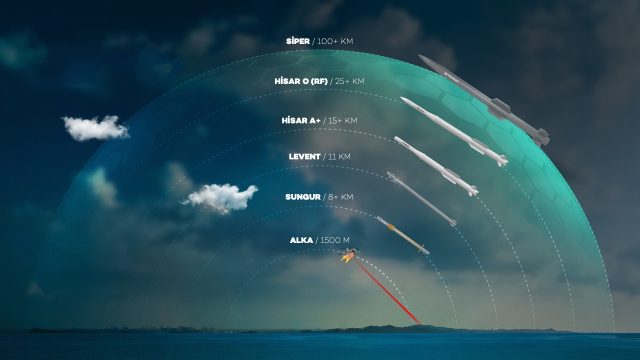Türkiye announced plans on Tuesday to form an indigenous multi-layered air defense system that features a network-centric and AI-supported multi-platform-integrated shield across large swaths of land, seeking to provide an impenetrable defense over Turkish airspace.
That would crown years of investments that have helped Türkiye transform from a nation heavily reliant on equipment from abroad to one where homegrown systems meet almost all of its defense industry needs.
For years, Ankara has voiced frustrations over its Western allies’ failure to provide adequate defense against missile threats despite Türkiye being a NATO member. It eventually took delivery of the advanced S-400 missile defense system made by Russia, a cooperation it hoped could help it develop its own defense program.
That triggered a major row with the United States, which Ankara says had first failed to supply it with the Patriot system. In response to its 2019 receipt of the Russian system, Washington barred Türkiye from buying and working on the multinational F-35 fighter jet program.
The “Steel Dome Project,” approved by the Defense Industry Executive Committee, chaired by President Recep Tayyip Erdoğan, on Tuesday, aims to integrate multiple layers of domestic air defense systems, sensors, and weapons under a unified network structure.
It will feature real-time data delivery to operation centers and leverage artificial intelligence technologies to support decision-makers.
Vice President Cevdet Yılmaz called the approval a “historic decision.”
“While utilizing all diplomatic means for regional and global stability and peace, we are determined to bring our country to a much stronger position against all kinds of threats,” Yılmaz wrote on social media platform X.
Aselsan, a pioneering defense electronics manufacturer, is spearheading the development of the “Steel Dome.”
The project will also include other prominent players like Roketsan, a producer of unguided rockets and guided missiles; TÜBITAK Defense Industries Research and Development Institute (SAGE); and Machine and Chemical Industry (MKE), which produces small arms, artillery and ammunition, said Haluk Görgün, head of the Presidency of Defense Industries (SSB).
Numerous news outlets and social media users shared illustrations on Tuesday depicting the platforms that will be included in the system.
The air defense network is said to feature four layers: very short range, short range, medium range, and long range. Many components of the project, such as short and middle-range systems, are already in military inventory.
For the initial layer, covering a maximum range of 10 kilometers (6.21 miles) and an altitude limit of 5 kilometers, Türkiye boasts various options developed by Aselsan, including Korkut, Gökberk, Şahin, Göker, Ihtar and Sungur.
For the low altitude layer, ranging from 5 to 10 kilometers, Türkiye has systems such as Herikks, C-Ram, Hisar A+, Gökdemir and Gürz.
The medium altitude layer, spanning 10 to 15 kilometers, could incorporate Kalkan 1, Kalkan 2, and Hisar O+.
Kalkan could serve as a sort of “watchman.” The system can be defined as a mobile air defense radar that detects incoming air threats. It is Türkiye’s first national air defense early warning radar, which has gained new capabilities over time.
The long-range layer, for altitudes between 15 and 30 kilometers and ranges exceeding 60 kilometers, could be served by Siper, Türkiye’s first long-range air defense system.
Expected to enter the inventory this year, its initial version boasts a range of 100 kilometers, with plans to extend this range in future iterations.
Defense breakthrough
Türkiye’s transformation over the last 20 years has aimed to reduce external dependency on Western arms through innovative engineering initiatives and domestically developed technologies.
The drive prompted the development of a range of homegrown air, land and marine platforms, eventually helping lower Türkiye’s foreign dependency on defense from around 80% in the early 2000s to some 20% today.
The capabilities of the Turkish defense platforms, spearheaded by its combat drones, triggered unprecedented demand, which saw its defense exports peak at more than $5.5 billion in 2023, up from an earlier record of $4.4 billion in 2022.
More than a third of exports were made by Baykar, the developer of the famed combat drone Bayraktar TB2.
The demand for Turkish defense products and the advancements have helped lift the number of Turkish firms in the Defense News Top 100 list for 2024 to five, up from four in 2023. They include Aselsan, Turkish Aerospace Industries (TAI), a leader in Turkish defense aerospace, Roketsan, MKE, and Military Factory and Shipyard Enterprise (AFSAT), which manufacturers and overhauls aircraft, naval and land systems.
“The defense industry not only ensures our security but also reduces our imports and supports our goals of high-value-added production and export. Last year, our exports reached $5.5 billion, and this year, our target is $7 billion,” said Yılmaz.
Among others, the Defense Industry Executive Committee on Tuesday discussed other critical projects and future goals, as well as the level achieved by the industry.
The meeting addressed projects for air defense and missile systems, Türkiye’s first homegrown fighter jet, Kaan, drones, including Baykar’s Bayraktar TB3 and Akıncı, TAI’s Aksungur, and various other unmanned aerial and maritime vehicles.
Kaan aims to replace Air Forces Command’s aging F-16 fleet, which will be phased out starting in the 2030s. The project was launched in 2016. Mass production of the first block is expected to be launched in 2028.
Kaan will make Türkiye one of the few countries with the infrastructure and technology to produce a fifth-generation combat aircraft.
The country has separately been testing various ranges of ballistic missiles since 2023.
“The meeting also addressed projects for enhancing the country’s space access capabilities, systems for improving situational awareness on land, air, and sea, electronic warfare systems, and defense systems against mini/micro UAVs and swarm-capable kamikaze unmanned maritime vehicles,” the statement by the Communications Directorate said.
Projects for modernizing tanks and fighter jets, developing engines and power systems for vehicles, and procuring command, control, and communication systems were also discussed during the meeting, it added.




